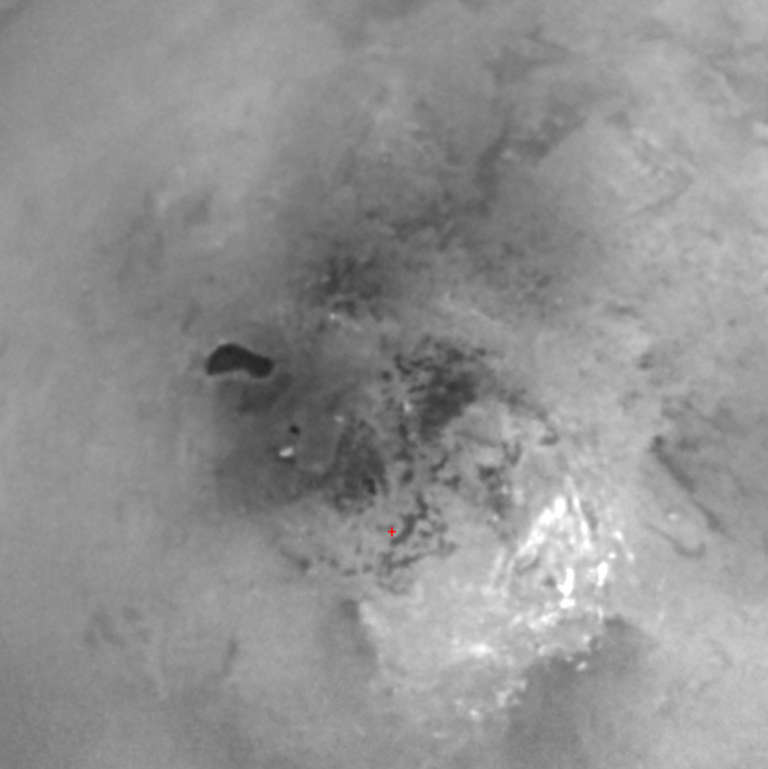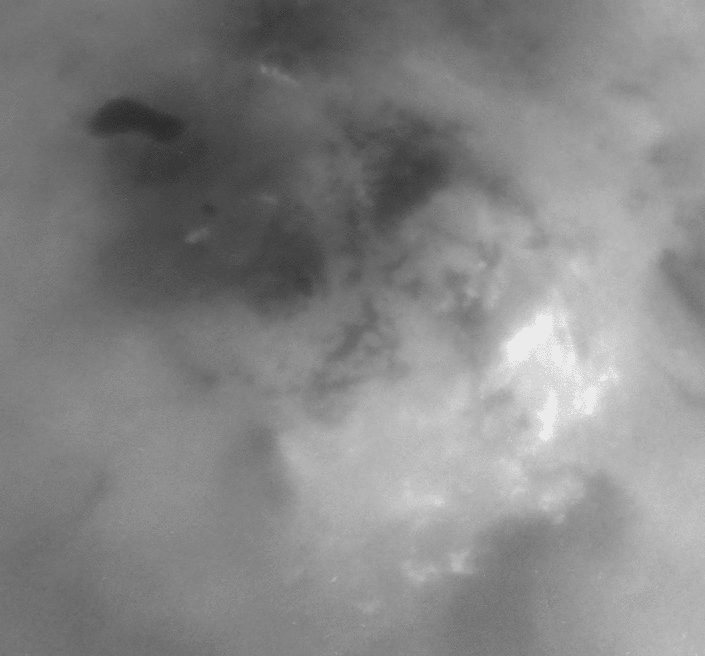Emily Lakdawalla • Jun 28, 2005
News: Dark Spot Near the South Pole: A Candidate Lake on Titan?
The Cassini imaging team has released an image containing a feature unlike any other that they have seen on Titan. The very dark color, curvaceous outline, and sharp edge of the feature have led them to the conclusion that it could well be the long-theorized but never-before-seen body of liquid hydrocarbons on the surface of Titan, although the evidence is far from conclusive.

The feature, which is 234 kilometers long by 73 kilometers wide (145 miles by 45 miles, or about the size of Lake Ontario) is located quite close to Titan's south pole. "When we first saw it, we all said, 'Holy cow! What is this? Its morphology is so distinct, it has very smooth boundaries, and it's standing apart from everything else. It just looks like a lake," said Carolyn Porco, the Team Leader for the Cassini Imaging Science Subsystem (ISS).
Porco explained that there are three lines of evidence that could support the idea of the feature being the long-sought-for lake, either now or in Titan's past. First of all, "It’s dark, darker than anything else around it, and a lake would look dark." Most surfaces look brighter to Cassini's cameras because they are rough enough that they scatter incoming light in all directions, so no matter which direction Cassini is looking from, its cameras see some scattered light. A mirror-smooth surface, on the other hand, exhibits "specular reflection," in which most or all of the incoming light bounces off the surface at the same angle at which it came in, like a billiard ball bouncing off the bumper of the table. Such surfaces look dark unless you happen to look at it from exactly the right angle, from which you would see a very bright glint.
The team's second line of evidence is a morphological one. "This thing has smooth boundaries, as if it was a lake that had boundaries that were smoothed by some sort of liquid erosion," Porco said. But, she acknowledged, the morphological argument is not unique. "You always have to look at the other things it could be. It could have formed by a different mechanism. It could be the top of a big volcanic structure that collapsed, and formed a caldera, and so the outline has nothing to do with erosion; maybe the stuff inside is solid hydrocarbons." In fact, team member Torrence Johnson observed, the feature has a morphological similarity to lava lakes seen on Io. Of course, the discovery of a collapsed volcanic caldera on Titan would be nearly as exciting a discovery as proof of a lake of liquid methane.
Finally, Porco explained, there is a strong circumstantial argument. "It’s located in a region that’s known to be the cloudiest on Titan. Now, Titan is not a very cloudy place. We’ve seen very few clouds on Titan. But if you had to point to some region that seems to have clouds more frequently than anywhere else, and more extensively than anywhere else, it’s the south polar region. So if there’s any place on Titan that is most likely to have present methane rain going on, it’s the south polar region."

Even if liquid methane is not quite stable on the surface of Titan, it's conceivable that there could be a long-lasting body of methane at the surface, provided you replenished it with rain, argues team member Anthony Delgenio. "It's possible that some of the storms in this region are strong enough to make methane rain that reaches the surface. Given Titan's cold temperatures, it could take a long time for any liquid methane collecting on the surface to evaporate. So it might not be surprising for a methane-filled lake to persist for a long time."
In sum, the arguments are suggestive, but there isn't a "smoking gun." The smoking gun would be that specular reflection, the telltale glint off of a liquid surface. Porco explained that the ISS instrument is never going to be able to see a specular reflection from this particular site. "To get a specular reflection, you have to have your angle to the vertical be the same as the sun’s angle relative to the vertical. But for the imaging experiment, we have tunnel vision when we look at Titan -- we [usually] look straight down and we can only look out to 30, 40, maybe 50 degrees from the nadir because otherwise it just gets too hazy." If the ISS instrument looks at too shallow an angle through TItan's atmosphere, the path of the camera's gaze through the atmosphere gets longer and longer, so the view gets more and more obscured by haze. As a result, the camera can only look at Titan at angles out to perhaps 50 degrees from the vertical. Unfortunately -- as is also true at the Earth's poles -- the Sun never rises high enough in the Titanian polar sky for the ISS to see liquid surfaces glinting through the haze there.
There is hope, though. The Visible and Infrared Mapping Spectrometer, or VIMS, can see through longer-wavelength "windows" to Titan's surface than the ISS can. These windows are less obscured by haze. As a result, VIMS can see Titan's surface even at very high "phase angles" (angles from the vertical). VIMS team member Larry Soderblom reports that VIMS can see to phase angles as high as 75 degrees, more than high enough for VIMS to be able to catch that glint. Even so, Cassini has to be in the right spot, and the team doesn't yet know whether any of the forty-odd future Titan encounters will put Cassini in the right place at the right time to catch a glint from this new candidate "lake."
The Time is Now.
As a Planetary Defender, you’re part of our mission to decrease the risk of Earth being hit by an asteroid or comet.
Donate Today

 Explore Worlds
Explore Worlds Find Life
Find Life Defend Earth
Defend Earth

